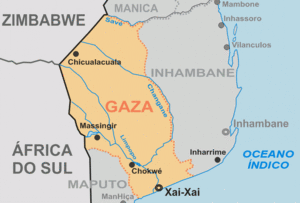Gaza Empire facts for kids
The Gaza Empire (1824–1895) was an African empire in southeastern Africa. It was located in what is now southern Mozambique and southeastern Zimbabwe. A general named Soshangane started this empire. At its largest in the 1860s, the Gaza Empire covered all of Mozambique between the Zambezi and Limpopo rivers. This area was known as Gazaland.
Contents
History of the Empire

In the 1820s, there was a big drought. Many Nguni groups, who spoke similar Bantu languages, started moving. These groups came from what is now South Africa and moved towards Mozambique.
One Nguni chief, Nxaba, created a small kingdom near Sofala. But in 1837, a strong Nguni rival, Soshangane, defeated him. Soshangane then set up his main base in the highlands near the middle Sabi River. This area is in present-day Zimbabwe. Soshangane named his new empire "Gaza" after his grandfather.
Soshangane passed away in 1856. After his death, his sons, Mawewe and Mzila, fought for control. With help from the Portuguese, Mzila won in 1861. He ruled the empire until 1884. Soshangane's grandson, Gungunyana, took over from his father Mzila. Gungunyana moved the capital south to Manjakazi. This move brought him closer to the Portuguese settlements.
During this time, the old African chiefdoms in the Zambezi region became weaker. This was due to the long drought, the rise of the Gaza Empire, and the Portuguese expanding their control. Instead, powerful warlords appeared. They built strongholds where rivers met and gathered private armies. They often took people from inland areas. One very powerful warlord was Manuel António de Sousa. He controlled much of the southern Zambezi Valley by the mid-1800s.
People of Gaza
The Shangaan people came from different groups. These included Nguni speakers (like the Swazi and Zulu) and Tsonga speakers. Other groups like the Ndau, Shona, and Chopi were also part of the empire. Soshangane had conquered many of these groups.
Soshangane wanted everyone to adopt Nguni customs. He also made the Tsonga people learn the Zulu language. Young Tsonga men joined the army as "Mavulandlela" (those who open the road). Soshangane also used Shaka Zulu's military system. He taught the people the Zulu ways of fighting.
For many centuries, Nguni peoples lived in small, family-based chiefdoms. They grew crops like millet and raised cattle. In the 1820s, the Zulu king Shaka started a big campaign of conquest. This period was known as the mfecane. Shaka's large armies conquered many nearby peoples. Some Nguni groups learned the Zulu fighting methods. They then used these methods to take control of other peoples' lands.
Empire's Expansion
The Gaza Kingdom included parts of what is now southeastern Zimbabwe. It also stretched from the Sabi River down to southern Mozambique. This covered parts of the current provinces of Sofala, Manica, Inhambane, Gaza, and Maputo. It also included nearby parts of South Africa.
Within the Gaza Empire's area, Nguni armies moved north. They set up military states that owned cattle along the edges of the Mozambican highlands. These states were good bases for raids into Mozambique.
Soshangane expanded his control over the area between the Komati and Zambezi rivers. He brought the local Tsonga and Shona peoples into his kingdom. These armed groups caused problems for trade and daily life in the area. Two groups, the Jere under Zwangendaba and the Ndwandwe under Soshangane, moved through Mozambique. Zwangendaba's group went north across the Zambezi. Soshangane's group crossed the Limpopo into the south.
Another army, led by Dingane and Mhlangana, was sent by Shaka to fight Soshangane. But this army faced many difficulties, like hunger and malaria. Soshangane easily drove them away in late 1828. During this time, from 1830 onwards, groups of Tsonga speakers moved south. They defeated smaller groups along the way.
Even though the Portuguese were pushed out of the highlands, they slowly gained more control. They moved up the Zambezi Valley and along the Mozambican coast. In 1727, they started a trading post at Inhambane. In 1781, they took over Delagoa Bay permanently. However, Soshangane's army overran these Portuguese settlements during the time of the Gaza Empire.
The empire under Soshangane has been criticized for its actions. It was involved in taking people from their homes between 1830 and 1897. It also faced accusations of mistreating the local peoples of Mozambique and Zimbabwe.
Decline of the Empire
After Soshangane died in 1856, his sons fought over who would rule next. Soshangane had chosen Mzila, but Mawewe believed he should be the leader. Mawewe attacked Mzila and his followers. This made them leave Mozambique and flee to the Soutpansberg Mountains in the Transvaal.
In 1884 and 1885, European powers divided Africa into different areas of control. This was part of the "scramble for Africa" by European countries. As a result, the Gaza Empire's land was given to Portugal. Gungunyana strongly fought against the Portuguese taking over. But he was eventually defeated. Gungunyana was sent away to the Azores, where he died in 1906. The Gaza Empire ended when the Portuguese defeated it in 1895.
Present Day
The lands that were once part of the Gaza Empire are now ruled by Mozambique, South Africa, and Zimbabwe. Mozambique has eleven provinces, and one of them is named Gaza.
The descendants of Gungunyana live in South Africa today. The current de jure king is Eric Mpisane Nxumalo. His request to be recognized as king was not accepted in 2012. Claims that the kingdom has authority over the Tsonga people of South Africa have also been rejected by Tsonga traditional leaders there.
See also


